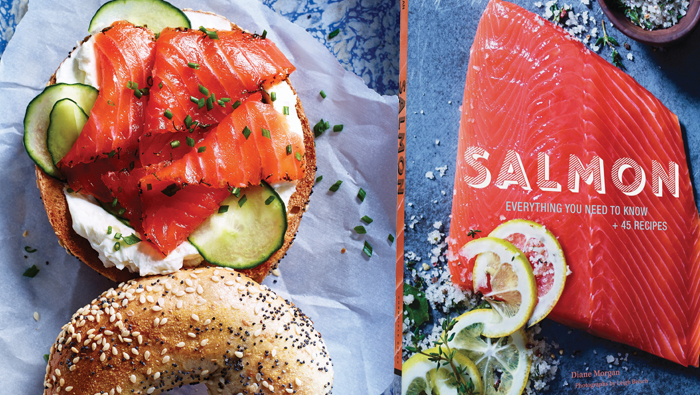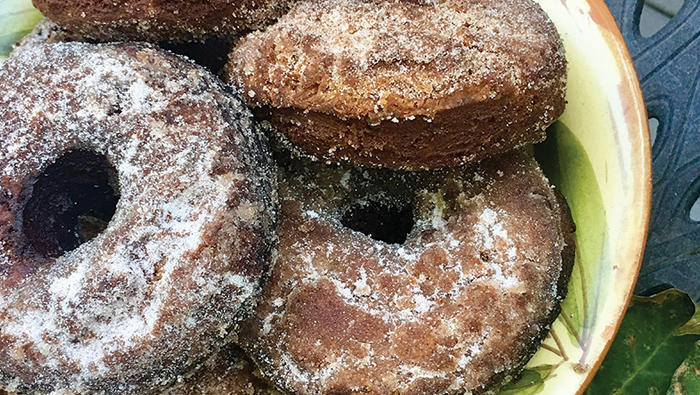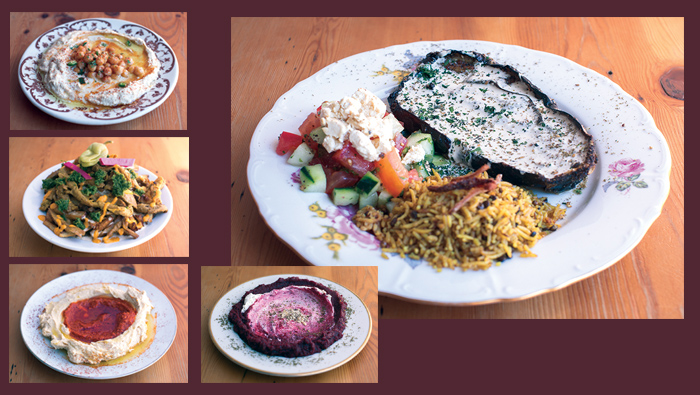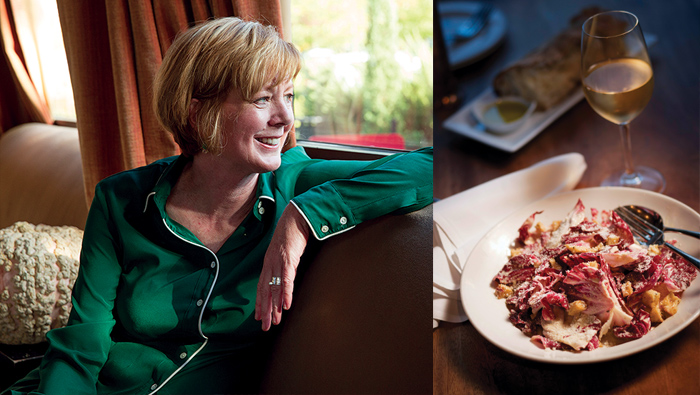
A few years ago, we had the opportunity to review Roots, the wonderful vegetable-focused cookbook by award-winning author and chef Diane Morgan. Now, Morgan returns with Salmon, a book of 45 tempting recipes that includes a guide to buying and preparing the tasty fish.
The chef begins her book with a fascinating overview of the salmon’s life cycle, after which she talks about the differences between Atlantic and Pacific salmon. This opening section is peppered with fascinating tidbits about salmon in our area. For example, did you know that the wild chinook season in Oregon begins in the middle of May, or that Coho stocks in Oregon are threatened and are protected under the Endangered Species Act? Another interesting observation is that Oregon’s coast is not well suited to salmon farming (“Thank goodness!” exclaims Morgan).
Says Morgan of our local bounty, “In Oregon, we can eat close to the source whether it be produce, poultry, meats or seafood. We are so fortunate to have a protected coastline and thoughtful resource management that allows wild-caught salmon to thrive and survive in our streams, rivers and in the ocean off the Oregon coast. That doesn’t mean there aren’t challenges for this incredible and healthful protein. There are abundant environmental threats such as pollution and water management. That said, supporting our local fishers and the producers who work hard to provide wild-caught salmon to our markets is key to survival. ‘Eat local’ applies to our seafood, too!”
Morgan reviews all of the health benefits of consuming salmon and then gives us an extensive primer on salmon preparation. If you’ve ever been intimidated by the prospect of cleaning, scaling and gutting a whole salmon, you won’t be after reading this book. Also, you will learn techniques for brining and skin-drying salmon.
The recipe section is divided into raw/cured, stovetop, oven, grill and leftover preparations. Morgan includes recipes for gravlax (salmon pickled in the style of herring) and even salmon pastrami (recipe below).
The chef remarks, “I grew up in a Jewish home in Pittsburgh, PA, where a Sunday brunch ritual was hand-sliced Nova Scotia lox, bagels and cream cheese, and sliced tomatoes and red onion as embellishments. It was a favorite brunch food when I was young and remains so today. The difference now is that my lox is either homemade by me or cold-smoked from wild-caught salmon.”
The remaining recipes in the book span the globe: there’s a salmon bánh mi, a Thai braised salmon with green curry paste and coconut milk; an Indian spice-rubbed, pan-grilled preparation; and even a broiled sesame salmon bibimbap. Breakfast lovers will appreciate the salmon hash with Yukon gold potatoes and the smoked salmon frittata with goat cheese and greens. The “bacon of the sea” recipe is sure to please anyone who avoids pork bacon. Those who primarily use the oven will find several different techniques, from sous-vide to pan-roasting to cooking in parchment.
No matter what your taste or preference, you will find something of interest in Morgan’s book. She concludes, “Whether you are a novice or experienced cook, these recipes will turn you into a masterful cook when it comes to salmon.”
PASTRAMI SALMON
Serves 8 to 10 as part of a brunch
While researching all the different ways to cure salmon, I ran across several old recipes for salmon cured with pastrami spices. I was intrigued. I mean, how could this not be delicious? I love lox. I love beef pastrami. Pairing salmon with this bold spice blend was worthy of my time in the kitchen. I combined a couple of techniques and decided to do a short cure time at room temperature, and then finish the salmon by smoking it briefly on the stove top. You can serve this salmon as you would lox, with cream cheese (or soft goat cheese) and bagels. Or, toast some pumpernickel or rye bread, smear it with a little dark mustard and top it with slices of the cured salmon.
PASTRAMI SPICE MIXTURE
2 tablespoon pink peppercorns
1½ tablespoon dry-packed green peppercorns
1 tablespoon black peppercorns
1½ teaspoons coriander seeds
2 tablespoon sweet paprika
1 tablespoon five-spice powder
½ cup coarse sea salt, such as La Baleine
½ cup sugar
½ cup chopped fresh dill
You will also need:
¼ cup pulverized apple-wood smoking chips
One 2- to 2½-pound center-cut salmon fillet, skin on and scaled, pin bones removed
TO MAKE THE SPICE MIXTURE:
Combine the pink, green and black peppercorns and the coriander seeds in a small, heavy-bottomed frying pan, preferably cast iron. Place the pan over medium-low heat and toast the spices, stirring frequently, until very fragrant, about 2 minutes. Remove from the heat, transfer to a small bowl and let cool for 5 minutes.
Using a mortar and pestle or a spice grinder (or a very clean coffee grinder), pulverize the toasted spices to a fine powder. Return the ground spices to the small bowl and stir in the paprika and five-spice powder. (The mixture will keep in an airtight container at room temperature for up to 3 months.)
In a medium bowl, combine the salt, sugar, dill and 1½ tablespoons of the pastrami spice mixture and mix well.
TO PREPARE THE SALMON: Select a deep glass or ceramic baking dish the same length as the fish or nearly so. Spread half of the salt mixture on the skin side of the salmon. Lay the salmon, skin-side down, in the dish. Gently rub the remaining salt mixture over the flesh side of the fillet. Cover the dish with plastic wrap and set aside at room temperature for 5 hours, flipping the salmon and recovering the dish after 2½ hours.
Using a stove-top smoker or a wok, line the bottom of the pan with a sheet of heavy-duty aluminum foil. (Using heavy-duty foil makes for easier cleanup.) Pour the smoking chips onto the foil in the center of the pan and spread in an even layer over the center. Sprinkle 1 tablespoon of the pastrami spice mixture evenly over the top. Drizzle a few drops of water over the spice mixture. If using a stove-top smoker, lay another piece of foil on top, covering all of the wood-smoking mixture. Cover a drip tray with foil and place it on top of the second piece of foil. If using a wok, lay a large sheet of foil loosely over the wood-smoking mixture. Coat a wire rack with nonstick cooking spray and place on top of the drip tray or the foil.
Scrape the salt mixture off both sides of the salmon with the back of a knife. Wipe each side of the salmon with a damp paper towel until most of the salt is removed. Arrange the salmon, flesh-side up, on the rack. Slide the lid on the stove-top smoker or cover the wok, leaving it slightly open, and then place the smoker or wok over medium heat. When the first wisp of smoke appears, close the lid or tightly cover the wok. Smoke the salmon for 5 minutes. Turn off the heat and leave the salmon in the smoker or wok, covered, for an additional 5 minutes.
Transfer the salmon to a plate to cool. Wrap tightly in plastic wrap and refrigerate. (Once cured and smoked, the salmon will keep in the refrigerator for up to 10 days.)
When ready to serve, transfer the salmon to a cutting board. Slide a spatula between the salmon flesh and the skin, separating them, and discard the skin. Cut the salmon crosswise (against the grain) into thin slices. Arrange the slices on a platter and serve.
(Reprinted with permission)





